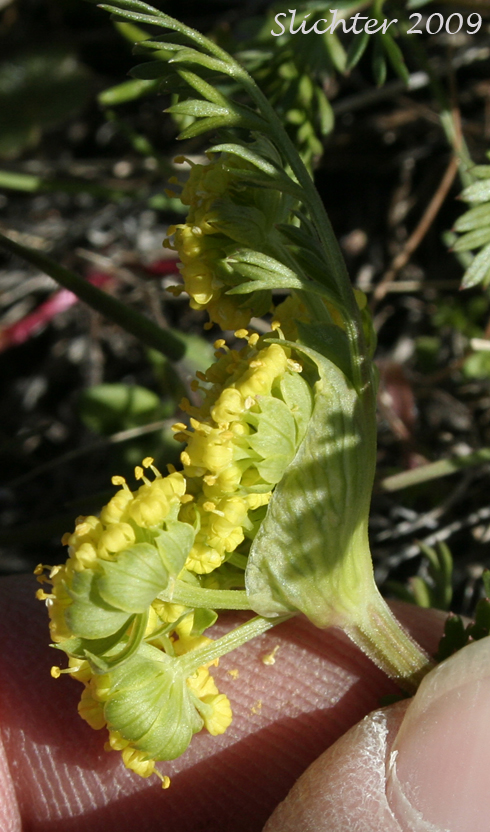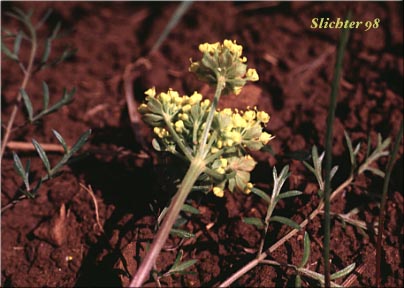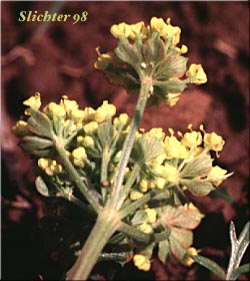Bladder Desert-parsley, Common Biscuit-root, Common Lomatium, Fine-leaved Desert Parsley, Pomocelery Lomatium, Pomo-celery Lomatium, Spring Gold
Lomatium utriculatum
Synonyms: Lomatium utriculatum var. anthemifolium, Lomatium utriculatum var. glabrum, Lomatium utriculatum var. utriculatum, Lomatium vaseyi

A close-up of fine-leaved desert parsley as photographed at Upper Table Rock to the north of Medford, OR........April 4, 2009. Note the broad, inflated bases of the leaf petioles which clasp the stem.
Characteristics:
Fine-leaved desert parsley is a perennial arising from a long, thin taproot, and ranges in size from 10 to 60 cm. The stems and herbage tend to be smooth rather than hairy. The leaves are found primarily on the stems. These leaves are typically ternate-pinnately dissected, with thin, segments less than 5 mm long and less than 1 mm wide. The petioles are long, and often flare to create a wide, striped, clasping junction with the stem.
The infloresence is an umbel, with the umbel segments of unequal lengths, and usually numbering less than 15. At their longest, these segments are 2 to 7 cm long. The involucre bracts below the flowers are obovate to elliptic or suborbicular, often with a toothed tip, or a shallowly serrate tip (see photo at right). The flowers are yellow.
Habitat:
Open areas such as grasslands and rocky outcrops.
Range:
Fine-leaved Desert Parsley is found west of the Cascade Mts from southern British Columbia to central California, and hence occasionally to southern California.
 -
- 
Two close-up views of the inflorescence of fine-leaved desert parsley. The photo at left above was photographed atop Upper Table Rock (north of Medford, OR) while that on the right was photographed on prairie slopes alongside Interstate 5 at Exit 1 in southwestern Oregon.........April 6, 2009.

A close-up of the involucel bracts of fine-leaved desert parsley as photographed atop Upper Table Rock to the north of Medford, OR........April 4, 2009. Note that the involucel bracts of this species are broadly elliptical or ovate in shape, while the similar Cook's lomatium (Lomatium cookii) has narrowly linear bracts.

Fine-leaved desert parsley as found on prairie slopes alongside Interstate 5 at Exit 1 in southwestern Oregon........April 6, 2009.
 -
-  -
- 
 -
- 
Fine-leaved desert parsley as found on a rocky piece of scabland at Nob Hill Park in St. Helens, OR.........April 3, 2016.
 -
- 
Fine-leaved desert parsley as seen in grasslands atop Upper Table Rock to the northwest of Medford, Oregon...........April 28, 2012.
 -
- 
Another view of the leaves and beneath the umbels of fine-leaved desert parsley as photographed at William L Finley National Wildlife Refuge.........mid April, 1998.
Paul Slichter
 -
- 